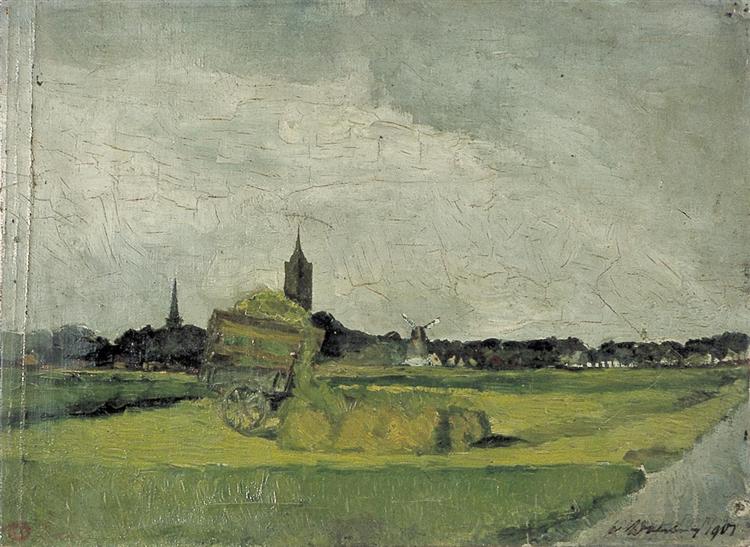Description
The painting "Landscape with hay car - Towers of church and windmill" by Theo Van Doesburg, made in 1901, is a work that encapsulates the transition between traditional landscape painting and the incipient avant -garde movements of the time. Van Doesburg, known mainly for its role in the development of neoplasticism, offers in this piece a representation that moves away from the rigidity of the academic approach and begins to explore new spatial and chromatic realities.
The composition of the work is characterized by a balanced disposition of the elements. In the foreground, a hay car becomes the focal point and is supported by the presence of geometric shapes that, although organic, suggest the influences of Cubism that would germinate later. The towers of the churches, located in the background, provide verticality to the scene, contrasting with the horizontality of the car and the extension of the terrain. This contrast not only gives the work of depth but also creates a dialogue between the rural and the urban, which is a recurring theme in the art of Van Doesburg.
The color in this painting is a vital aspect that demands attention. Van Doesburg uses a land and naturalistic palette that evokes the tones of the field. Greens, brown and yellow have a vibrant quality that not only represents nature, but also suggests a sense of life and movement. The chromatic range seeks to capture the light and atmosphere of the landscape, and at the same time, it establishes a visual rhythm that invites the viewer to travel the work. This color choice is significant in the context of its evolution towards a more abstract and rational use of color in its subsequent works.
As for the presence of human figures, painting seems to be stripped of visible characters, which suggests an introspection in the landscape. This allows the viewer to focus absolutely on the interaction between the elements of nature and the built space, creating a contemplative experience. This absence of figures can also be interpreted as a reflection on the place of the human being in the natural environment, an echo of the search for a new way of seeing the world that Van Doesburg pursued in his career.
"Landscape with hay car" not only points to a visual representation, but also hints at a broader historical and cultural context. At the beginning of the twentieth century, Europe was in a state of constant change, where artistic traditions were being continuously challenged. Van Doesburg, by capturing this landscape, also documes a moment of transformation, where technique and perception were on the threshold of a new era. This type of work could be considered as a bridge between impressionism and future abstract explorations.
In summary, this painting stands as a testimony of Van Doesburg's mastery, before it was consecrated as one of the great masters of neoplasticism. Through a skilled manipulation of shape, color, and composition, "landscape with hay car" not only creates an aesthetic representation of the landscape, but also invites a deeper reflection on the relationship of the human being with its around. The work remains a subtle echo of its time, capturing the essence of a world in transformation.
KUADROS ©, a famous paint on your wall.
Hand-made oil painting reproductions, with the quality of professional artists and the distinctive seal of KUADROS ©.
Art reproduction service with satisfaction guarantee. If you are not completely satisfied with the replica of your painting, we refund your money 100%.

